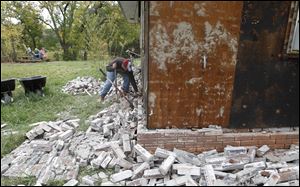
Scientists seek explanations for Oklahoma quakes
Some point to drilling, but industry dismisses possibility
11/20/2011
Chad Devereaux works at cleaning up the bricks that fell from three sides of his in-laws home in Sparks, Okla., Sunday, after two earthquakes hit the area in less than 24 hours.
MEEKER, Okla. -- Geophysicist Katie Keranen was burying a seismometer on a farm in what is supposed to be tornado, not earthquake, country when a trio of figures came striding across the misty cow pasture, all dressed in camouflage.
Ashley Gilbreth, 33, and her two children had been hunting when yet another earthquake hit, a magnitude-3.6 temblor accompanied by a thunderous boom.
Bowdie Gilbreth, 13, whose school was closed this day for quake-induced ceiling repairs, had been perched in a deer stand 17 feet high in the trees. Bowdie and his 11-year-old sister, Megan, clung to the rails as if they were riding a roller coaster. What, they asked Ms. Keranen, is going on in Oklahoma?
It's what everyone here wants to know.
Ms. Keranen, an assistant professor at the University of Oklahoma in Norman, was among scientists dispatched by the Oklahoma Geological Survey, Oklahoma State University, the U.S. Geological Survey, and other research groups after the Meeker area was rocked by a magnitude-5.6 quake on Nov. 5, the strongest in state history.
In a state that's home to 185,000 drilling wells, a pressing question is whether industrial drilling has been triggering the quakes. Mike Terry, president of the Oklahoma Independent Petroleum Association, dismissed any connection between the two. "To try to blame it on an industry that's been around for hundreds of years is pretty far-fetched," Mr. Terry said.
Geologists have traced the quakes to the Wilzetta fault. Ashley Gilbreth, like many in the area, had never heard of it until the earthquakes led her to comb through the Oklahoma Geological Survey Web site. There she saw a long black line representing the fault running under the property where she and her husband plan to build their new home.
"My husband thinks it's the drilling, all the holes they left behind," she said.
"They draw so much out of the earth," said Gene Gilbreth, 65, her father-in-law, who owns the farm and has leased land to an oil company, "Something's got to give."
Ms. Keranen told the Gilbreths it was unlikely that drilling caused the latest quakes but that researchers will ask that question as they compile readings from the seismometers.
Meeker, with a population of fewer than 1,000, lies at the center of the state, one of the small towns strung along U.S. 62. Oil and gas drilling operations are not evident here.
The recent quakes caused no major injuries but damaged scores of homes. As of last week, the area had seen more than 20 quakes of magnitude-3 or greater since the record quake and more than 200 smaller aftershocks.
Some researchers claim recent earthquakes in Arkansas, California, Texas, England, Germany, and Switzerland were caused by drilling or injection wells, underground pipes that are used to dispose of waste water.
Of particular interest to some is hydraulic fracturing, or fracking, which involves shooting water infused with chemicals and sand at high pressure into the ground to fracture rock and extract oil and gas. It produces waste that may be deposited in injection wells.
Accompanying Ms. Keranen to the farm was another geophysicist from the university, Austin Holland. Earlier this year, Mr. Holland examined possible connections between earthquakes and drilling in Garvin County to the south. While he found some correlation, he said it was impossible to say drilling caused the quakes.
Jean Antonides, a geologist and vice president of exploration at New Dominion, a Tulsa-based oil and gas producer with wells near the recent quakes' epicenters, said the latest temblors were more likely caused by the complex underlying fault system.
"It's like a system of underground mountains. A lot of people don't realize that. They just see flat Oklahoma," Mr. Antonides said. "If people really saw the structures under their feet that they drive across every day, they'd be shocked."